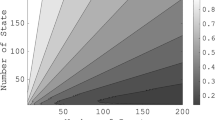Abstract
We introduce linear control systems, termed chattering systems, which model instantaneous oscillations in the control parameters. Such systems serve as a limit case of systems with rapidly oscillating control parameters, which can be analyzed as perturbations from the chattering model. Several optimization and regulation problems for chattering systems are examined, along with the robustness property: the possibility of employing the solutions of the chattering case in the rapidly oscillating approximations. The theory is demonstrated on an example of an armature-controlled dc motor.
Similar content being viewed by others
References
B. D. O. Anderson and J. B. Moore,Linear Optimal Control, Prentice-Hall, Englewood Cliffs, NJ, 1971.
Z. Artstein, Discrete and continuous bang-bang and facial spaces, or: Look for the extreme points,SIAM Rev.,22 (1980), 172–185.
Z. Artstein, Stability, observability and invariance,J. Differential Equations,44 (1982), 224–248.
Z. Artstein, Uniform controllability via the limiting systems,Applied Math. Optim.,9, (1982), 111–131.
Z. Artstein, A variational convergence that yields chattering systems,Ann. Inst. Henri Poincaré Anal. Non Linéare (to appear).
H. Attouch,Variational Convergence for Functions and Operators, Applicable Mathematics Series, Pitman, London, 1984.
P. Billingsley,Convergence of Probability Measures, Wiley, New York, 1968.
R. W. Brockett,Finite-Dimensional Linear Systems, Wiley, New York, 1970.
C. Castaing and M. Valadier,Convex Analysis and Measurable Multifunctions, Lecture Notes in Mathematics, vol. 580, Springer-Verlag, Berlin, 1977.
R. E. Kalman, Contributions to the theory of optimal control,Bol. Soc. Mat. Mexicana,5 (1960), 102–119.
B. C. Kuo,Automatic Control Systems, 2nd edn., Prentice-Hall, Englewood Cliffs, NJ, 1967.
J. Kurzweil and Z. Vorel, Continuous dependence of solutions of differential equations on parameters,Czechoslovak Math. J.,7 (1957), 568–583.
W. H. Kwon and A. E. Pearson, A modified quadratic cost problem and feedback stabilization of linear systems,IEEE Trans. Automat. Control,22 (1977), 838–842.
E. B. Lee and L. Markus,Foundations of Optimal Control Theory, Wiley, New York, 1967.
D. Russel,Mathematics of Finite-Dimensional Control Systems, Marcel-Dekker, New York, 1979.
L. Tartar, Compensated compactness and applications to partial differential equations, inNonlinear Analysis and Mechanics (R. J. Knap, ed.), pp. 136–211, Heriot-Watt Symposium, Vol. 4, Pitman, London, 1975.
J. Warga,Optimal Control of Differential and Functional Equations, Academic Press, New York, 1972.
T. Yoshizawa,Stability Theory and the Existence of Periodic Solutions and Almost Periodic Solutions, Springer-Verlag, New York, 1975.
L. C. Young,Calculus of Variations and Optimal Control Theory, Saunders, Philadelphia, PA, 1969.
Author information
Authors and Affiliations
Rights and permissions
About this article
Cite this article
Artstein, Z. Chattering linear systems: A model of rapidly oscillating coefficients. Math. Control Signal Systems 2, 359–380 (1989). https://doi.org/10.1007/BF02551277
Received:
Revised:
Issue Date:
DOI: https://doi.org/10.1007/BF02551277




